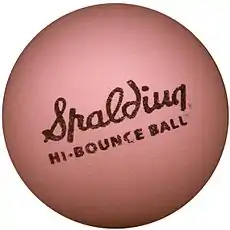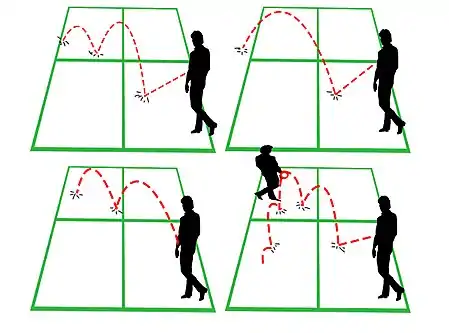Handball (school)
School students in Australia, New Zealand, Fiji, South Africa, China and South East Asia often play a style of handball, also known as four square, Downball or n-square (the number, n, in the latter determined by the number of players), that differs from most other types of handball. The game is most frequently played at recess, lunchtime, or before and after school. It can also be played at home or anywhere that has a hard surface and at least one line. The quick set-up time, and the simple rules, contribute to the game's popularity.

| Players | 2 minimum |
|---|---|
| Skill(s) required | Manual dexterity Strategy Social skills Hand-eye coordination Endurance Strength Determination |
Unlike most types of handball, this version does not incorporate a wall, instead being played on a court consisting of lines on the ground. A typical handball court is a square split into four, usually marked by painted lines or expansion joints, with the highest and most prestigious position on the court being Ace, followed by King, Queen, and Dunce. The most radical difference from American handball is that players must hit the ball (usually a tennis ball or a high-bounce ball) so that it bounces in their own square first, before it bounces in another player's square. The receiving player, in whose square the ball bounces, must then hit the ball by hand, ensuring that it bounces within the receiver's own square once, and then an opponent's square. Failure to do so, or hitting the ball out of court, results in that player being relegated to the lowest position on the court, or becoming the last of the players waiting to enter the court.
Due to the social nature of handball and its simplicity, many variations in the rules can occur. For example, students in one school might play in a square of four, while in the next school the game might involve a straight line of six squares, radically altering the game. In addition, some variations of the game allow for the head or feet to be used to return the ball. While the rules may vary between schools, the basic rules usually remain the same. This article only covers the most common rules and is not representative of every variation.
Rules
Basic rules
- A game must have at least two players.
- The person in the leading square 'serves' the ball, bouncing it once within their square before entering an opponent's square.
- Once the serve is complete, the receiver must hit the ball to another player.
- The ball must be hit so that it bounces in the player's own square on the first bounce, and into another player's square on the second bounce.
- If an outside object interferes with the play, the point will be replayed.
- When a player is 'out', they must proceed to the lowest square, or to the end of the line of players waiting to enter the court. Players on the court who were of a lower position each move up a square.
- Full/Straight: when the ball lands in another player's square on the first bounce, the player has 'fulled' or has hit a 'foul'.
- Out: when the ball lands outside of the court, the last person who touched the ball or the last court the ball touched is out.
- Double Bounce: when the ball bounces twice in a person's square, the person who is in that square is out. Usually known as 'double', 'double bounce'.
- If the first bounce lands on the line and is not a 'full' or a 'double', it is known as a 'liner'. When a 'liner' is called the point is replayed.
- Double Touch: when the ball is touched twice in a row by the same person.
- Grabs/Carry: when the ball is held or scooped instead of a clean hit.
- Interference: if a player interferes with another player, they are usually out.
- Rolls: if the player hits the ball in such a manner that it rolls along the ground, without bouncing, they are out.
- Rebound: in some schools, the ball can be rebounded off an outside object or a wall and is allowed one bounce back in the players square.

The court
Even though each part of the court is referred to as "squares", they can be any shape or size. Edges or 'lines' can be marked with any material: paint, expansion joints, cracks, chalk, or points where the square meets an object such as a wall or locker. Commonly, the court has either a bitumen or concrete surface. Depending on the school, the squares will either be labelled Ace, King, Queen and Dunce or King, Queen, Jack and Dunce.[1]

In popular culture
Handball has entered the current meme culture. In March 2013, former Australian prime minister Kevin Rudd released a video of him playing handball at Brisbane State High School,[2] which led to him becoming part of a 'handball meme'. In late November, 2017, Rudd played handball with students in a school in Brisbane, and the accompanying video - claiming he was the "king of handball' - reached 40,000 views on Facebook.[3]
Handball is the main theme of the children's television series, Handball Heroes, which aired on ABC Me (Then ABC 3) in 2013, as well as Hardball (2019 TV series) which aired on ABC Me in 2019[4][5]
References
- "Four Square Handball Rules" (PDF). Moore Teaching Tips.
- Kevin Rudd (2013-03-10), Playing handball at Brisbane State High School, retrieved 2017-10-31
- "Handball Memes". www.facebook.com. Retrieved 2017-10-31.
- "Handball Heroes". ABC Television. Retrieved 2017-10-31.
- "Hardball". IMDb. Retrieved 2020-10-31.